
About UsThe Numismatic Bibliomania Society is a non-profit organization promoting numismatic literature. For more information please see our web site at coinbooks.org SubscriptionsThose wishing to become new E-Sylum subscribers (or wishing to Unsubscribe) can go to the following web page link MembershipThere is a membership application available on the web site Membership Application To join, print the application and return it with your check to the address printed on the application. Membership is only $15 to addresses in the U.S., $20 for First Class mail, and $25 elsewhere. For those without web access, write to: David M. Sundman, Treasurer AsylumFor Asylum mailing address changes and other membership questions, contact David at this email address: dsundman@LittletonCoin.com SubmissionsTo submit items for publication in The E-Sylum, just Reply to this message, or write to the Editor at this address: whomren@gmail.com
BUY THE BOOK BEFORE THE COIN |
- WAYNE'S WORDS: THE E-SYLUM MARCH 9, 2014
- ASYLUM OCTOBER-DECEMBER 2013 ISSUE PUBLISHED
- 500 YEARS OF NUMISMATIC LITERATURE
- NEW BOOK: OF CARSON CITY MORGAN DOLLARS, 3RD EDITION
- NEW BOOKS IN THE MONETA SERIES: #168-#172
- BOOK REVIEW: AMERICAN NUMISMATIC AUCTIONS TO 1875
- LOUIS HUDSON, 1942-2014
- UPDATE ON THE JOHN BURNS ESTATE
- DOWNIES TO SELL WILLIAM D. CRAIG COLLECTION
- NOTES FROM E-SYLUM READERS: MARCH 9, 2014
- CLASSIC NUMISMATIC QUOTES
- A CANCELLED CARSON CITY HALF DOLLAR DIE
- QUERY: COIN RUBBINGS
- MORE ON THE "SADDLE RIDGE" GOLD COIN HOARD
- BITCOIN CREATOR SATOSHI NAKAMOTO UNMASKED?
- KÜNKER PRODUCES VIDEO TO PROMOTE MALTA SALE
- ROYAL MINT PRODUCES MULED DIE ERROR COINS
- BRITISH MUSEUM UNVEILS COIN MAPPING SYSTEM
- UNIQUE COIN FIND IN TURKEY 'DEMON TRAP'
- ODYSSEY MARINE TO ATTEMPT SS CENTRAL AMERICA SALVAGE
- SOME NEW COIN DESIGNS: MARCH 9, 2014
- QUERY: BALD PEOPLE ON COINS
- EDWARD VI SHILLING FOUND VICTORIA, BRITISH COLUMBIA
- COUNTERFEITERS HIT GIRL SCOUT TROOPS
- BANK OF INDIA GOOFS GOVERNOR'S SIGNATURE
- FEATURED WEB PAGE: SS CENTRAL AMERICA ROBOT ARMS
Click here to access the complete archive
To comment or submit articles, reply to whomren@gmail.com
WAYNE'S WORDS: THE E-SYLUM MARCH 9, 2014

New subscribers this week include Duane Blake and Hero Hodel. Welcome aboard! We have 1,711 email subscribers.
This week we open with the contents of the latest issue of our print journal, The Asylum, a notable numismatic literature anniversary, six new books and one review. Other topics include the late John Burns and Louis Hudson, along with the still-kicking-at-95 author William D. Craig.
To learn more about the first printed numismatic book, American numismatic auctions before 1876, the remarkable Price Sale of 1813, the New England Numismatic and Archaeological Society, classic numismatic quotes, coin rubbings, Satoshi Nakamoto, the Dimmick Defalcation, and bald people on coins, read on. Have a great week, everyone!
Wayne Homren
Editor, The E-Sylum
ASYLUM OCTOBER-DECEMBER 2013 ISSUE PUBLISHED
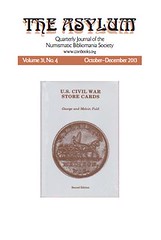 Another issue of The Asylum is at the printers. Here are the contents:
Another issue of The Asylum is at the printers. Here are the contents:
- John W. Adams - From the Editor-in-Chief
- Arnold Tescher - Hidden Voices in the ANS Archives: Emmanuel J. Attinelli Heard Again
- Thomas D. Harrison - Thomas Elder's Commission Campaign
- Bill Bugert - Hints on Self-Publishing
- Jon P. Amato - Numismatic Literature as a Research Tool
- Myron Xenos - "You Don't Say": Numismatic Quarterly Quiz
- George Kolbe - Reminiscences of a Numismatic Bookseller 3 George Fuld - Reminiscence
- Tony J. Lopez - A Tribute to Dr. George Fuld, 1932-2013
- David F. Fanning - Off the Shelf
- Jon P. Amato - Rejoinder to Review of The Draped Bust Half Dollars of 1796-1797
- Scott A Blickensderfer - Book Review: A Guidebook of Civil War Tokens, by Q. David Bowers
- John W. Adams - Book Review: John J. Ford, Jr. and the "Franklin Hoard", by Karl V. Moulton
To access the NBS membership application, see: www.coinbooks.org/club_nbs_member_app.html
500 YEARS OF NUMISMATIC LITERATURE

At my request David also provided the text of the lot description from the last time Kolbe & Fanning sold a copy of the first edition of the first numismatic book. Thanks. Here's an excerpt. -Editor
Budé, Guillaume. DE ASSE ET PARTIBUS EIUS LIBRI QUINQ[UE] GUILLIELMI BUDEI PARISIENSIS SECRETARII REGII. VENUNDANTUR IN EDIBUS ASCENSIANIS. (Paris, March 1514). Colophon: Finis libri quinti & ultimi de Asse & partibus eius: Guillielmi Budei Parisien. a secretis regiis: In chalcographia ascensiana ad Idus Martias. MDXIIII. [358 pages] (7), CLXXII printed leaves [2 leaves numbered LXXIII, no LXXIIII, as issued; 2 leaves numbered CXVI, no CXV, as issued; leaf CLXV numbered CLXIIIII]; title printed in gothic letter within a superb woodcut border, with a large woodcut of Badius Ascensius’s printer’s device of a printing shop in the center; woodcut initials.
Ex John Drury Catalogue XXXII, 1978, item 28: “The rare first edition of this classic numismatic treatise which may be regarded as the first printed numismatic book.” Nearly two decades have elapsed since we have been privileged to offer a first edition of this landmark foundational work. “De Asse eiusque partibus (1514), based on the careful research of nine years, became the definitive text book for the study of Roman coinage and metrology” (Rudolf Pfeiffer, History of Classical Scholarship, 1300–1850, page 101). “After the publication of De Asse, Budé was celebrated as the principal French humanist, equal to Erasmus, or indeed superior” (Contemporaries of Erasmus, 1985, Volume I, pages 214–215). “[T]he greatest work on numismatics prior to [the] volume of Fulvio is the De Asse of Guillaume Budé, published in Paris in 1514.
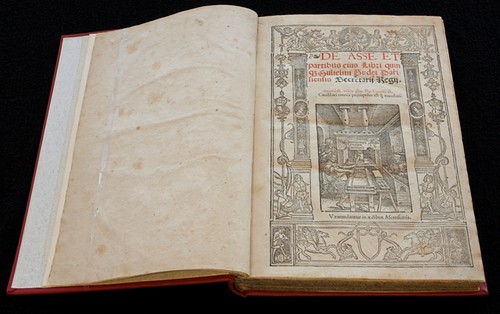
To read the complete article, see: Bude, Guillaume (Budaeus), (1467 - 1540) De Asse et partibus euis. Paris: Jose Bade, 1516? (numismatics.org/Library/Bude)
NEW BOOK: OF CARSON CITY MORGAN DOLLARS, 3RD EDITION
 Whitman Publishing announces the release of the updated and revised third edition of Carson City Morgan Dollars , by Adam Crum, Selby Ungar, and Jeff Oxman. The new 136-page hardcover book debuted at the American Numismatic Association’s National Money Show in Atlanta, Georgia, March 1, 2014. It is available from booksellers and hobby shops nationwide, and online (including at www.Whitman.com), for $24.95. The book can also be borrowed for free as a benefit of membership in the ANA, through the Dwight N. Manley Numismatic Library.
Whitman Publishing announces the release of the updated and revised third edition of Carson City Morgan Dollars , by Adam Crum, Selby Ungar, and Jeff Oxman. The new 136-page hardcover book debuted at the American Numismatic Association’s National Money Show in Atlanta, Georgia, March 1, 2014. It is available from booksellers and hobby shops nationwide, and online (including at www.Whitman.com), for $24.95. The book can also be borrowed for free as a benefit of membership in the ANA, through the Dwight N. Manley Numismatic Library.
The third edition has been updated with new historical photographs; revisions from ongoing research; current coin values and certified-coin populations; and fresh market commentary. A new appendix gives current certification populations of Carson City Morgan Dollars as graded by NGC. “This gives the collector and investor a real-world snapshot of the relative rarities of different dates and more than a dozen VAM varieties,” said coauthor Adam Crum.
Carson City Morgan Dollars begins with the accidental discovery of gold in California in 1848. Crum, Ungar, and Oxman describe the challenges faced by adventurers in the Gold Rush; the Nevada silver boom of the late 1800s; the birth and struggles of the Carson City Mint; and other rich historical topics.
“Old West history buffs strike it rich with this book,” said Whitman publisher Dennis Tucker, “and collectors and investors benefit from its detailed coin-by-coin study of every Morgan dollar ever struck at the famous CC Mint, including selected VAM (Van Allen–Mallis) varieties.”
The General Services Administration hoard—millions of Treasury-bagged Carson City silver dollars brought out of storage in the 1970s and sold to collectors—is a fascinating “main character” in this story. The authors describe the government’s sales of these coins, and their effect on the hobby. Then they share detailed advice on ways to collect Carson City Morgan dollars.
- Each coin-by-coin entry has a chart of values in Mint State grades, listing prooflike (PL) and deep-mirror prooflike (DMPL) values separately.
- Each “generic” (non-VAM variety) coin has a “By the Numbers” chart, which gives its original mintage, Leroy Van Allen’s published estimate of the quantity in the GSA hoard, rarity rankings for GSA and non-GSA examples, and other useful facts. “Overall Rarity” is the total number of coins estimated to exist for the issue, based on the number found in the GSA hoard, the number graded by PCGS and NGC, the authors’ personal observations of the market, insider information, and auction records.
- A “Condition Census” provides the most reasonable acquisition grade for most collectors. (“Though it isn’t always possible to acquire the highest-graded coins in GSA holders,” the authors note, “it’s still desirable, and fun, to attempt to do so.”)
- “Collector Insights” summarize useful background information on each coin.
- “Variety Notes” supply valuable information on the many die varieties known to exist for Carson City Morgan dollars in GSA holders.
- A “Collector’s Checklist” includes space for collectors to record their purchases and write notes about their coins.
- An index allows the reader to quickly search for terms—from Adams Brick Works to Brigham Young—relating to the Carson City Mint and its silver dollars.
Hobby legend Q. David Bowers, the “Dean of American Numismatics,” calls Carson City Morgan Dollars “a necessary volume in your silver-dollar library.”
Carson City Morgan Dollars, 3rd edition
By Adam Crum, Selby Unger, and Jeff Oxman; foreword by Q. David Bowers
ISBN 079484227-5
Hardcover, 6 x 9 inches
136 pages
Full color
Retail $24.95 U.S.
Online at
/www.whitman.com/store/Inventory/Detail/Carson-City-Morgan-Dollars-3rd-Edition+0794842275

Archives International Auctions, Part XVII
Rare U.S. & Worldwide Banknotes, Scripophily, Security Printing Ephemera, Further Selections From the Hamtramck Collection & Part 1 of the Scarsdale Collection of Modern African Banknotes
Highlights include:
- Lot 102 Banco de Quito. 5 Pesos. 1880. Pick #S242 Unlisted as issued note
- Lot 704 Essay Proof of Merchants National Bank of Chicago - a rare essay proof of original issue national banknote
- Lot 394 Central African Republic, 5000 Francs, P-11
- Lot 837 Crescent Mutual Insurance Co., ca.1850's Specimen Stock Certificate
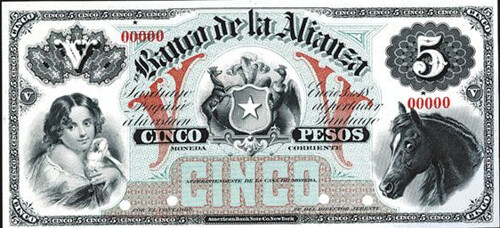
1580 Lemoine Avenue, Suite #7
Fort Lee, NJ 07024
Phone: 201-944-4800
Email: info@archivesinternational.com
WWW.ARCHIVESINTERNATIONAL.COM
NEW BOOKS IN THE MONETA SERIES: #168-#172
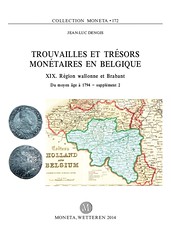 The first 2014 volumes are now published with books on coin finds in Belgium and several volumes of our DAMIN program on Silver monetary depreciation and international relations (on India this year) and a volume on Bosporan coinage.
The first 2014 volumes are now published with books on coin finds in Belgium and several volumes of our DAMIN program on Silver monetary depreciation and international relations (on India this year) and a volume on Bosporan coinage.
On the website, you will find all the previous publication up to 2013 (167 volumes) on
- ancient, medieval or modern numismatics,
- monetary history,
- economy,
- Asia,
- Japan, etc.
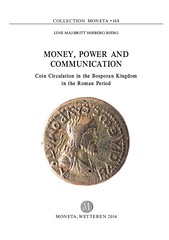
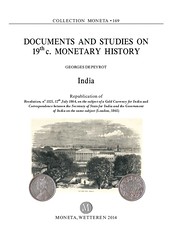

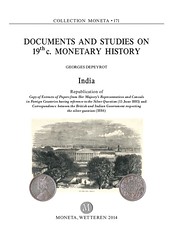
The Moneta web site (www.moneta.be) has been completely improved, with the possibility to order by visa/MasterCard
You can find the information of the DAMIN program on www.anr-damin.net
For more information, or to order, see: www.moneta.be
BOOK REVIEW: AMERICAN NUMISMATIC AUCTIONS TO 1875
 I have been slowed by the holidays and my chronic ill of over-commitment, but I want to inform you that I have been reading American Numismatic Auctions to 1875 with great interest, and I don't want to wait until completion to extend congratulations to you on an extraordinary contribution to American numismatic literature.
I have been slowed by the holidays and my chronic ill of over-commitment, but I want to inform you that I have been reading American Numismatic Auctions to 1875 with great interest, and I don't want to wait until completion to extend congratulations to you on an extraordinary contribution to American numismatic literature.
I would be fibbing were I to say that I agree with every one of your conclusions--I remain, for instance, unsure about your thesis that there were three distinct groups of printings of Numisgraphics --but any disagreements pale compared to the vast mass of important new information you have brought to the banquet. The most remarkable of these new finds, in my view, is the Price Sale of 1813, which you demonstrate was the first exclusively numismatic auction held in America--nearly 40 years prior to the Roper sale!--and remarkable, too, for containing the still-intact coin cabinet of Pierre Eugene Du Simitiere!
These new finds are important in many respects, but nearest to my heart is the way they finish the old erroneous conception that numismatics in the United States sprang, like Athena fully armed from Zeus's forehead, suddenly into being during the 1850s. I have long maintained that there was a considerable prior period of development, particularly during the first half of the 19th century, but I had insufficient evidence to make that insight stick. Your data vindicate this view completely.
American Numismatic Auctions to 1875 is a significant contribution to the history of American numismatics. I am sure that I will learn much more as I read it through to completion, but for now, John, I wanted to give you well-deserved kudos for a signal accomplishment. Please do put me on the list to purchase the succeeding volumes you have in contemplation!
For more information, or to order, see: NEW BOOK: AMERICAN NUMISMATIC AUCTIONS TO 1875 (www.coinbooks.org/esylum_v16n30a04.html)
THE BOOK BAZARRE
LOUIS HUDSON, 1942-2014
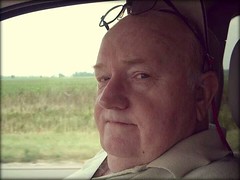 I am very sad to report that Louis Hudson died Wednesday. He was a magnificent numismatist, vastly knowledgeable in the field of Latin American numismatics and a truly good man. He was a great mentor to me and good friend to all who knew him; he loved sharing his knowledge and was generous to a fault. But for a series of unfortunate hard knocks in life he would have been one of the most successful numismatists in the business.
I am very sad to report that Louis Hudson died Wednesday. He was a magnificent numismatist, vastly knowledgeable in the field of Latin American numismatics and a truly good man. He was a great mentor to me and good friend to all who knew him; he loved sharing his knowledge and was generous to a fault. But for a series of unfortunate hard knocks in life he would have been one of the most successful numismatists in the business.
Louis got his start in numismatics while working for an American tobacco company in Argentina in the 1960s. There he became fluent in Spanish and began to make contacts throughout South America. He handled many of the greatest rarities in Latin American coins and paper money known today, and helped to build significant collections such as the Amon Carter collection.
Louis lived out his final days in Greensboro, North Carolina, and died of kidney failure. I will miss him always. Donations in his memory can be made to the Patrick Henry Boys and Girls Home in Brookneal, VA, www.patrickhenry.org
Louis grew up on a tobacco farm in Virginia and was attracted to early colonial coins uncovered by his plow at a young age. In 1967, Louis moved to Argentina after responding to a Philip Morris ad to teach tobacco farming to the local community. While there, Louis became fluent in Spanish and began visiting local silversmiths to buy coins. He brought those coins back to sell in the US and this avocation led to full time dealing when the Philip Morris project ended a few years later.
Louis Hudson is one of the foremost authorities in Spanish colonial coinage. He was a fixture at coin shows and important auctions around the world. His knowledge and influence were evident in countless publications and numismatic collections, perhaps the most important of which was that of the Central Bank of the Dominican Republic, which he single-handedly appraised in 2002 for over 50 million dollars by today's standards. Louis was assisted in the last years of his career in the numismatic business by his daughter, Stephanie who today continues Louis' legacy.
To read the complete article, see: HUDSON, LOUIS (www.news-record.com/obituaries/article_1ef26b67-c758-5047-9732-2826ad21a6a9.html)
UPDATE ON THE JOHN BURNS ESTATE
A number of publications, including The Numismatist from the American Numismatic Association have published tributes to numismatic literature dealer John H. Burns, who passed away during the FUN Show earlier this year. As but one example, in the official publication of the Original Hobo Nickel Society, Bo Tales Sandy Pearl wrote:
On a sad note, used book dealer John Burns took the westbound during the show. He went with his boots on and will be remembered by many of us as a fair, honest and friendly person. He sold me Del Romines' first Hobo Nickel guidebook, signed by Del and Bill Fivaz, among others I have bought from him. He will be missed by all who knew him. (Spring 2014, p17)
"Taking the westbound" is Hobo code for death. John would be honored to have the phrase applied to him. Pat McBride is the executor of John's estate, and we'd like to pass along this update for E-Sylum readers.
First, we'd like to thank everyone who donated to the John H. Burns Memorial Fund, supervised by the Pennsylvania Association of Numismatists (PAN). Over $5,000 was raised, and these funds allowed Pat to arrange John's cremation, pay his rent, and travel to Florida to retrieve John's ashes, personal effects, truck and numismatic literature stock, which had been carefully looked after by officers of the Florida United Numismatists (FUN).
Much of that money has now been spent. Pat can provide information to any donor curious about the details. The estate is solvent for the time being, but further donations will be welcomed, and will help in the interim before all of John's books and coins can be prepared for sale. Click on the ad below to be taken to the PAN web site to make a donation. Remember, the estate will reimburse the fund as John's inventory is sold, and it will be managed henceforth by PAN to promote numismatic literature and education.
This week Pat and a number of helpers from western Pennsylvania coin clubs have begun cleaning John's townhouse and organizing his numismatic literature holdings, which go far beyond the truckload he took to shows. It's a big job, and I'll be up in Pittsburgh next weekend to assist.
As noted earlier, a service/dinner/wake will be held on Friday May 9, 2014 during the PAN show in Monroeville, PA. We look forward to seeing many of John's friends there. Stay tuned for further information.
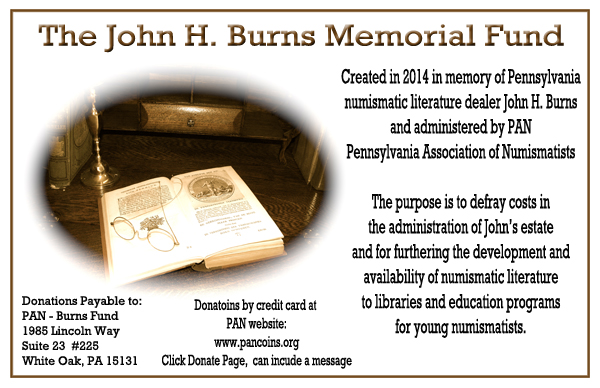
To read the earlier E-Sylum article, see: JOHN H. BURNS 1958-2014 (www.coinbooks.org/esylum_v17n02a02.html)
DOWNIES TO SELL WILLIAM D. CRAIG COLLECTION
 In late February Downies announced they had scored a major coup for their July auction, the sale of the William D. Craig collection of world coins.
In late February Downies announced they had scored a major coup for their July auction, the sale of the William D. Craig collection of world coins.
It is regrettable that Craig’s name may mean little to too many readers. For the benefit of those with a lot less grey hair than myself, long before there was a Standard Catalog of World Coins, there was Craig and Yeoman. These two authors compiled the coin catalogs that became the principle source of information on world coins for thousands of collectors around the globe. Their C- and Y- catalogue numbers are still used by SCWC for a number of countries. Yeoman dealt with issues post-1850. Craig catalogued the coins of 1750-1850. In his Coins of the World 1750-1850 Craig states, “This catalog is designed to extend Richard S. Yeoman’s A Catalog of Modern World Coins backward another century” …
William D. Craig was born in the USA c. 1920. He became an attorney. Somewhere along the way he fell in love with Germanic coins. His first enterprise in numismatic authorship came in 1954 with his privately published Germanic coinages (Charlemagne through Wilhelm II). It became the standard reference in the field.
His world coin book first appeared in 1966 with the lengthy title: Coins of the World 1750-1850 I: Coins of the Western World; II: Coins of Africa and Asia. I always assumed that more volumes had been intended.
After four and half years of research a corrected and enlarged version in a larger format appeared in 1971 having the shortened title. A third updated edition was published in 1976.
In 1966 Craig upped-sticks and moved to Hobart, Tasmania. Here he discovered a new passion: Australian revenue stamps. Over thirty years he complied, edited and published nine comprehensive catalogues of Commonwealth and Australian States revenue stamps. The first on Tasmania appeared in 1978; the last for Victoria in 1999. The most recent update was issued in 2002.
Each catalogue was a scholarly work. Each came annotated and included newly researched information that had not been published previously. Like his Germanic coinage work these were privately published by Craig under the moniker Revenue and Railstamp Publications.
Today at a highly respectable 95 he resides in a nursing home on the Aussie mainland. His collection will comprise a major segment of Downies sale 317 on July 8-10 to be held in their Block Arcade auction rooms, 98 –100 Elizabeth Street, Melbourne. The catalog for this sale is currently being compiled. Interested readers wanting details will need to keep a weather eye on the Downies website: www.downies.com/aca.
Catalogs can be ordered now from phone: +613 8677 8800; fax: +613 8677 8899; email: auctions@downies.com

NOTES FROM E-SYLUM READERS: MARCH 9, 2014
Query: Thomas Machin Signature Sought Kathy Lawrence writes:
While researching a Colonial paper item, I noticed a Thos. Machin signature and am trying to determine whether it belonged to the well-known Thomas Machin. Do any E-Sylum readers have any documents with his signature I can view for comparison?
Query: Shows Featuring Coins Sought Alan Meghrig writes:
I have been trying to locate two movies/TV shows where coins were a part of the plot.
One was a foreign film where they were after a counterfeiter of Chinese 'Cash' coins. There was a scene where they point to a package of dies of same.
I located a story in: Matlock 'The Thief Pt1 & Pt2', 1988 Season 3 Disc 4; where Matlock takes his fee of $100,000 in coins. Matlock also talks 'coins' to a coin dealer. The defense resolves around a Proof coin as evidence of who is actually guilty. Not quite as I remembered it so there may be another Matlock episode dealing with coins again.
New England Numismatic and Archaeological Society Publications Web site visitor Tamara Gaydos of the Phillips Library in the Peabody Essex Museum in Salam, MA writes:
I just discovered your 2010 posting in The E-Sylum about the New England Numismatic and Archaeological Society. The query was from Dave Hirt. As the archivist here at the Phillips Library, I am cataloging manuscripts and I came across some records for the Society. They are dated 1865 to 1878 and consist of the constitution, bylaws, correspondence and a list of donations and purchases. None of this is digitized. If anyone are interested in examining it, we have a Reading Room open to the public on Wednesdays and Thursdays from 10:00am to 4:30pm in our temporary location in Peabody, MA. Please see our website (www.pem.org/library) for directions.
To read the earlier E-Sylum article, see: QUERY: NEW ENGLAND NUMISMATIC AND ARCHAEOLOGICAL SOCIETY PRLS (www.coinbooks.org/esylum_v13n19a20.html)
CLASSIC NUMISMATIC QUOTES
Howard Daniel has a friend who is looking for some good quotes on numismatics to reference in an planned book. “Numismatics is the Hobby of Kings” is an old saying, but has it ever been attributed as a quote to anyone in particular? Of course, numismatic bibliophiles are aware of the Aaron Feldman “Buy the book before the coin” quote. But other than these two, my feeble brain was having trouble thinking of more numismatic quotes.
A web search turned up these:
"Coin collecting is the only hobby where you can spend all your money and still have some left." (unattributed)
"Numismatics: A pursuit involving a veneer of scholarship hiding a core of greed. " Walter Breen
To read the complete article, see: Classic numismatic quotes... (www.coincommunity.com/forum/topic.asp?ARCHIVE=true&TOPIC_ID=2057)
And this... (how could I have missed this one?):
"There is no Santa Claus in numismatics." Lee Hewitt, founder of The Numismatic Scrapbook Magazine.
To read the complete article, see: February 18, 2009: Notable Numismatic Quotables, Part I (www.coinraritiesonline.com/index.php?page=entry&thread_id=1&id=109&thread_name=Coin+Commentary)
Howard also asked Dick Johnson, and he coined a new quote (I like this one!):
“Coin collecting is a hobby for boys, an investment for fathers, and a windfall for grandfathers.” D. Wayne Johnson
So, readers, can you help? What famous classic numismatic quotes can we add to this list? There must be many, and not all in English. Any pithy NEW quotes you'd like to offer?
THE BOOK BAZARRE
A CANCELLED CARSON CITY HALF DOLLAR DIE
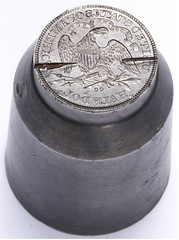 In late January, David Sundman, President of the Littleton Coin Company and Treasurer of the Numismatic Bibliomania Society, [You should consider joining if you are not already a member - see www.coinbooks.org.—Editor] sent me an email with the following information and images. This article is an extract of my research and answer to David.
In late January, David Sundman, President of the Littleton Coin Company and Treasurer of the Numismatic Bibliomania Society, [You should consider joining if you are not already a member - see www.coinbooks.org.—Editor] sent me an email with the following information and images. This article is an extract of my research and answer to David.
Per David, “I thought you might enjoy these images of a Carson City half dollar cancelled reverse die, circa 1875 that I bought several years ago from Fred Weinberg. What is unusual is that it is lightly cancelled, without the prominent “X” through the entire design. Fred described it as circa 1875. I was thinking that possibly you or one of your project participants might be able to tell me the year(s) it would have been used to produce coinage? My dream would be to obtain a coin that had been struck from this die—but realize that is like searching for a needle in a hay stack! According to Fred Weinberg, this dies had been used by a Virginia City, NV family as a doorstop.”
Background facts. I studied the images of the die and determined that it is a half dollar die with a large size CC mintmark of the Carson City Branch Mint. As I detail in my book, A Register of Liber-ty Seated Half Dollar Die Varieties, Volume II, Carson City Branch Mint, a total of six Carson City reverse dies with a large CC mintmark are known to have mint half dollars. These six dies were used during five years of coinage at the Carson City Branch Mint.
According to mine and Randy Wiley’s 1980’s research of the National Archive’s mint correspondence files, the Philadelphia Mint shipped reverse dies (presumed to be Large CC) to the Carson City Branch Mint as early as October 20, 1869 when two reverse dies were received. Carson City received other reverse dies almost yearly but a different size mintmark was not introduced in half dollar Carson City coinage until 1873.
Of particular note is the question, “is your half dollar die one of these six dies?” In short, yes it is! Your die has diagnostics that match die #1 (used only in 1870-CC with die pair WB-1A, die marriage WB-1 shown in the image at the right). Those diagnostics include the position of the letters CC on the die. Please note that a letter C logotype was punched into the die two times in slightly different unique positions to make up the CC mintmark. To confirm that the die is the same as the die #1, I overlayed the image of the 1870-CC WB-1 mintmark on the die. I flipped the image of your die to give the same perspective as a coin. The following overlayed image shows an exact match in the mintmark position between the die and the WB-1 variety.
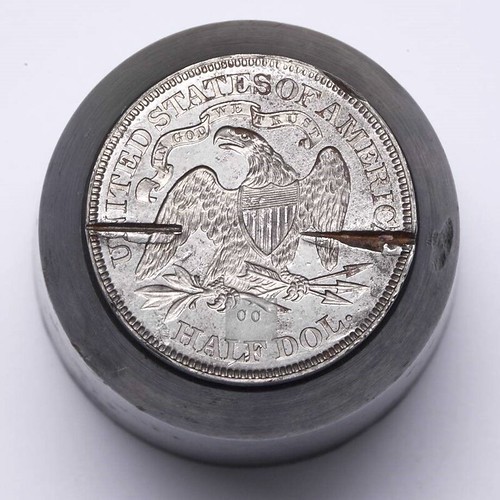
Conclusion / Opinion. It is my opinion that David Sundman’s Carson City half dollar die (as depicted in this letter) is the same die that was used to mint 1870-CC WB-1 half dollars. It is not currently known to have been used to coin any half dollars in another year. I am unsure when the die was canceled but it was the practice of the time for the Branch Mint to cancel all used dies.
In searching my personal files, I determined this die sold in a December 2003 Holabird Americana Auction. The following image is a scan of the Numismatic News announcement of the sale of this die.
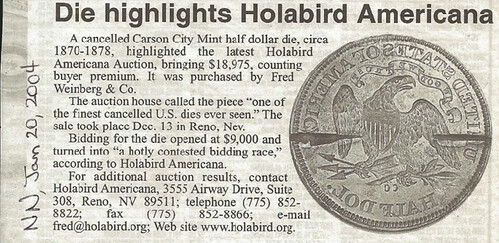
Quite a nice doorstop, eh?
To read the complete issue, see: 2014 Volume 10, Issue 3 March 2014 (Whole # 110) (www.seateddimevarieties.com/110-E-GobrechtVolume10,Issue3.pdf)
In an email, Dave Bowers added:
Can you use it to strike for me a specimen in Hershey’s dark chocolate?
QUERY: COIN RUBBINGS
Fred Michaelson writes:
I just got this neat book by the Guttag Brothers of New York, containing amounts they would pay for coins. My question concerns the coin images: are they drawn by an artist or are they "rubbings"? I've heard of rubbings but I don't remember ever seeing any.
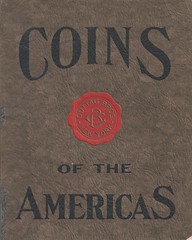
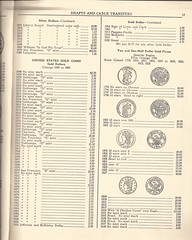
Great question! For those who haven’t seen rubbings, they’re actually very easy to make yourself, assuming you can still find a pencil and blank piece of paper in this digital age. Give it a try! Lay the coin on a flat surface and put the paper over it. Now hold the pencil flat, nearly parallel with the paper. Gently rub the business end of the pencil (the graphite, or “lead”) back and forth across the paper directly on top of the coin. Slowly an image of the coin will appear.
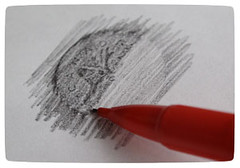 Practice your technique a few times and soon you’ll be a pro. Back in the day numismatists often kept notebooks of rubbings of their coins as a record of their collection. In fact, when I liquidated a fellow numismatist’s collection several years ago, the most valuable item turned out to be a book of rubbings – at $2,000 it sold for almost twice what the most valuable coin brought.
Practice your technique a few times and soon you’ll be a pro. Back in the day numismatists often kept notebooks of rubbings of their coins as a record of their collection. In fact, when I liquidated a fellow numismatist’s collection several years ago, the most valuable item turned out to be a book of rubbings – at $2,000 it sold for almost twice what the most valuable coin brought.
Rubbings don’t damage the coin (at least, not circulated ones). They’re fragile because the graphite can smudge if you’re not careful. But in the days before scanners and digital cameras, when photography was slow and expensive, rubbings were a great way to record a collection, and still work in a pinch.
I found these instructions online:
www.ehow.com/how_4481075_do-coin-rubbing-paper.html
www.primeradicals.ca/math-mentors/activities/coin-rubbings/
www.blogmemom.com/art-math-activities-coin-rubbings
As for the Guttag book, these images look to me to be woodcuts. An artist would engrave these in a block of wood (in reverse), and the block would be inked to print the image on the page. They may also have been done in another medium, - perhaps an E-Sylum reader can provide more information.
EMPLOYMENT OPPORTUNITY!
Live and Work in Southern CaliforniaStack’s Bowers Galleries offers an important employment opportunity for the right person. We are seeking an experienced numismatist in the American series—coins, tokens, medals, and paper money—to work with our “dream team” of catalogers, building on the tradition of the Ford, Eliasberg, Bass, Cardinal, Norweb, Battle Born and other great collections.
If you can write in an authoritative and compelling manner with a high degree of accuracy, this may be just right for you! You will be working in Irvine, a modern community in dynamic Orange County, California—one of the finest areas to live. We offer generous benefits including medical and dental coverage, 401K plan, and more. Our offices are in our own modern, state-of-the art building with all amenities.
If you would like to be considered for this position please contact Q. David Bowers by mail or by email with your resumé, samples of your past writing (on numismatics or other subjects), and salary requirements: Mail to the attention of Q. David Bowers, PO Box 1804, Wolfeboro, NH 03894. Email to: Ckarstedt@stacksbowers.com
MORE ON THE "SADDLE RIDGE" GOLD COIN HOARD
Martin Kaplan writes:
I vote last week's issue the #1 E-Sylum because of your work on the "Saddle Ridge Gold Hoard". A Iot more to this story than first reported and what has been making the headlines. Great job!
Ron Ward writes:
The definitive reference on coin find laws can be found on the internet. It is an article by John M. Kleeberg with hundreds of legal citations. The article is: The Law and Practice Regarding Coin Finds - Treasure Trove Law in the United States.
California does not have treasure trove laws. However, Kleeberg points out that sales of coins from hoards are subject to Federal taxes and are considered as ordinary income, not capital gains. A very important consideration concerns the owner of the land: private?, Federal or State?, Indian land? In the latter case, everything is confiscated.
To read the complete article, see: THE LAW AND PRACTICE REGARDING COIN FINDS Treasure Trove Law in the United States (www.muenzgeschichte.ch/downloads/laws-usa.pdf)
The rare coin expert who is helping a California couple sell $10 million in gold pieces they dug up said Tuesday that there is no way the mother lode came from a 1900 heist at the San Francisco Mint.
That theory has been floating around since the so-called Saddle Ridge Hoard — a cache of 1,427 coins minted between 1847 and 1894 and buried under a tree in cans — came to light last week.
But David McCarthy, senior numismatist for Kagin's, said it's about as likely as a three-dollar bill.
Even though the number and value of the coins swiped from a cashier's vault at the mint match the hoard, McCarthy reeled off a list of reasons they're not one and the same:
- The mint's vault probably would have held bags containing coins from a single year with identical mint marks, but the hoard is much more diverse.
- The hoard contains many coins that were heavily circulated, but the mint would have melted down and reissued those, not stored them.
- There are 50 $10 gold coins in the hoard. Those were never mentioned in accounts of the mint heist, also known as the Dimmick Defalcation.
- The hoard's coins don't have what experts call "bag marks," which they would expect to see on coins that had been vaulted for any length of time.
- None of the hoard coins have dates after 1894, which would mean they would have been stored for six years at a minimum if they were from the mint job. "Who keeps 6-year-old inventory, especially of something that is not hard to get rid of?" McCarthy said.
Based on where the coins were discovered a year ago, McCarthy thinks they were amassed by someone doing a lot of a business in gold and who buried each can as soon as it was filled up, possibly over a span of 20 years.
An unexpected death would explain why they were abandoned — only to be found by the anonymous couple walking their dog on their property a century later.
"You can't take it with you," he said.
To read the complete article, see: Bunch of bullion: Dealer says gold coin hoard not from heist (www.cnbc.com/id/101465936)
What I find fascinating about this story is that it is the first great “treasure “ to be found in the day of Web 2.0. When the lost 1913 Nickel was rediscovered a few years ago, it certainly made the rounds on the web, but stayed mainly in numismatic circles. And when the greatest find of them all, the S.S. Central America, was discovered oh so many years ago, there wasn’t even an internet around for the story to go viral; it had to build its momentum over the course of months; not moments.
Much of the information I read online about the source and origin of the coins was seemingly invented by reporters who never bothered to check their source(s), and some blatantly wrong numismatic information was written by “news” sources who should have known better. Stolen coins…uh, I don’t think so. Special presentation piece made to commemorate the death of President Lincoln…? Nope.
Wrong information aside, the coins provided the gold coin market was the type of exposure you’d have to spend millions of dollars to generate. It was a true viral buzz and any coin story that doesn’t involve a Long Island telemarketer swindling a little old lady for her life savings is a good story in my book.
One thing that will be interesting to see is how the collectors who focus on shipwreck coins view this hoard. As an example, “unique” coins from the S.S. Central America (i.e., coins which were one of a kind from the shipwreck) now bring a huge premium due to their collectability; something which was not the case even six or eight years ago. What sort of premium will the only Dahlonega half eagle from this hoard be accorded? My guess is that the premium will be quite significant, and that these coins will be collected alongside the S.S. Central America, Brother Jonathan and S.S. Republic shipwreck coins.
To read the complete article, see: The Saddle Ridge Gold Coin Hoard: Some Thoughts (www.coinweek.com/commentary/opinion/saddle-ridge-hoard-thoughts/)
Numerous theories have cropped up since the discovery of the Saddle Ridge Hoard was announced last week.
Another suggests the coins may have been buried by the Knights of the Golden Circle, a secretive, subversive Confederate group that some believe buried millions in ill-gotten gold across a dozen states to finance a second Civil War.
Though the coins very well could be a fortune buried by a wealthy businessman, the time period, markers near the cache and manner in which the coins were buried fit the mold of the KGC, said Warren Getler, a former Wall Street Journal reporter who coauthored “Rebel Gold,” a book about the group.
Getler and coauthor Bob Brewer argue in the book the KGC existed for many decades after the Civil War and continued to bury and protect underground gold and silver caches.
To read the complete article, see: Gold coins found by California couple unlikely stolen from U.S. Mint (www.latimes.com/local/lanow/la-me-ln-gold-coins-northern-california-mint-theft-20140304,0,3666293.story#axzz2vP7GtuVr)
BITCOIN CREATOR SATOSHI NAKAMOTO UNMASKED?
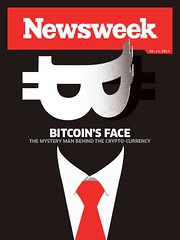 Satoshi Nakamoto stands at the end of his sunbaked driveway looking timorous. And annoyed.
Satoshi Nakamoto stands at the end of his sunbaked driveway looking timorous. And annoyed.
He's wearing a rumpled T-shirt, old blue jeans and white gym socks, without shoes, like he has left the house in a hurry. His hair is unkempt, and he has the thousand-mile stare of someone who has gone weeks without sleep.
He stands not with defiance, but with the slackness of a person who has waged battle for a long time and now faces a grave loss.
Two police officers from the Temple City, Calif., sheriff's department flank him, looking puzzled. "So, what is it you want to ask this man about?" one of them asks me. "He thinks if he talks to you he's going to get into trouble."
"I don't think he's in any trouble," I say. "I would like to ask him about Bitcoin. This man is Satoshi Nakamoto."
"What?" The police officer balks. "This is the guy who created Bitcoin? It looks like he's living a pretty humble life."
I'd come here to try to find out more about Nakamoto and his humble life. It seemed ludicrous that the man credited with inventing Bitcoin - the world's most wildly successful digital currency, with transactions of nearly $500 million a day at its peak - would retreat to Los Angeles's San Gabriel foothills, hole up in the family home and leave his estimated $400 million of Bitcoin riches untouched. It seemed similarly implausible that Nakamoto's first response to my knocking at his door would be to call the cops. Now face to face, with two police officers as witnesses, Nakamoto's responses to my questions about Bitcoin were careful but revealing.
Tacitly acknowledging his role in the Bitcoin project, he looks down, staring at the pavement and categorically refuses to answer questions.
"I am no longer involved in that and I cannot discuss it," he says, dismissing all further queries with a swat of his left hand. "It's been turned over to other people. They are in charge of it now. I no longer have any connection."
Nakamoto refused to say any more, and the police made it clear our conversation was over.
But a two-month investigation and interviews with those closest to Nakamoto and the developers who worked most frequently with him on the out-of-nowhere global phenomenon that is Bitcoin reveal the myths surrounding the world's most famous crypto-currency are largely just that - myths - and the facts are much stranger than the well-established fiction.
Far from leading to a Tokyo-based whiz kid using the name "Satoshi Nakamoto" as a cipher or pseudonym (a story repeated by everyone from Bitcoin's rabid fans to The New Yorker), the trail followed by Newsweek led to a 64-year-old Japanese-American man whose name really is Satoshi Nakamoto. He is someone with a penchant for collecting model trains and a career shrouded in secrecy, having done classified work for major corporations and the U.S. military.
Standing before me, eyes downcast, appeared to be the father of Bitcoin.
Not even his family knew.
Bitcoin is a currency that lives in the world of computer code and can be sent anywhere in the world without racking up bank or exchange fees, and is then stored on a cellphone or hard drive until used again. Because the currency resides in code, it can also be lost when a hard drive crashes, or stolen if someone else accesses the keys to the code.
"The whole reason geeks get excited about Bitcoin is that it is the most efficient way to do financial transactions," says Bitcoin's chief scientist, Gavin Andresen, 47. He acknowledges that Bitcoin's ease of use can also lead to easy theft and that it is safest when stored in a safe-deposit box or on a hard drive that's not connected to the Internet. "For anyone who's tried to wire money overseas, you can see how much easier an international Bitcoin transaction is. It's just as easy as sending an email."
In 2008, just before Bitcoin's official kickoff, a somewhat stiffly written, nine-page proposal found its way onto the Internet bearing the name and email address of Satoshi Nakamoto.
The paper proposed "electronic cash" that "would allow online payments to be sent directly from one party to another without going through a financial institution," with transactions time-stamped and viewable to all.
The masterstroke was replacing the role of banks as the trusted middlemen with Bitcoin users, who would act as sentinels for the integrity of the system, verifying transactions using their computing power in exchange for Bitcoin.
Bitcoin production is designed to move at a carefully calibrated pace to boost value and scarcity and remain inflation proof, halving its quantity every four years, and is designed to stop proliferating when Bitcoins reach a total of 21 million in 2140. (Bitcoins can be divided by up to eight decimal places, with the smallest units called "satoshis.")
Nakamoto's family describe him as extremely intelligent, moody and obsessively private, a man of few words who screens his phone calls, anonymizes his emails and, for most of his life, has been preoccupied with the two things for which Bitcoin has now become known: money and secrecy.
For the past 40 years, Satoshi Nakamoto has not used his birth name in his daily life. At the age of 23, after graduating from California State Polytechnic University, he changed his name to "Dorian Prentice Satoshi Nakamoto," according to records filed with the U.S. District Court of Los Angeles in 1973. Since then, he has not used the name Satoshi but instead signs his name "Dorian S. Nakamoto."
Dorian S. Nakamoto's use of English, she says, was likely influenced by his lifelong interest in collecting model trains, many of which he imported from England as a teenager while he was still learning English.
Mitchell suspects Nakamoto's initial interest in creating a digital currency that could be used anywhere in the world may have stemmed from his frustration with bank fees and high exchange rates when he was sending international wires to England to buy model trains. "He would always complain about that," she says.
To read the complete article, see: The Face Behind Bitcoin (mag.newsweek.com/2014/03/14/bitcoin-satoshi-nakamoto.html)

KÜNKER PRODUCES VIDEO TO PROMOTE MALTA SALE
Ursula Kampmann writes:
On March 11, 2014 Künker will offer an outstanding collection of coins and medals of the Sovereign Military Order of Malta. In order to reach a wide circle of all those interested, the auction house located in Osnabrück is breaking fresh ground. The numismatists have produced a film on the topic. It features not only the highlights of the collection, but it gives additionally the numismatic-historical background.
Ulrich Künker delights in this new concept: “Certainly, Künker is aware of the company’s tradition, nevertheless we are constantly improving our presence in the modern media. We hope that this film will delight coin collectors. We also hope that it will inspire internet users who have not known anything about coins at all. Finding new ways of sharing our passion is a real pleasure for us.”

Was this coin made during the siege of Rhodes, or did it originate in Malta?
To view the ten-minute video on YouTube, see: Künker spring sale 2014: Coins and medals of the Sovereign Military Order of Malta (http://youtu.be/YOuMfQl-JjQ)
ROYAL MINT PRODUCES MULED DIE ERROR COINS
The Royal Mint in Wales has confirmed the existence of a pair of £2, .999 fine silver mules, which the Mint says were mistakenly produced and sold in December 2013.
In Numismatics, the term “mule” describes a coin that’s struck using two dies not designed to be paired together.
In this instance, the confirmed mules were produced by accidentally combining the following dies:
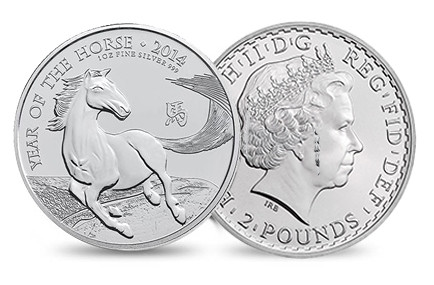
£2 Lunar Horse without denticles reverse paired with Britannia denticled obverse
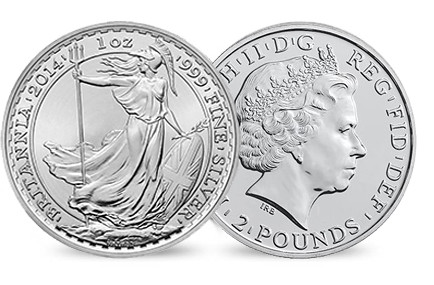
£2 Britannia denticled reverse paired with Lunar Horse non-denticled obverse
According to Mint Spokesperson Victoria Newman, “The mismatched dies were used on approximately 17,000 Britannia and 38,000 Lunar coins.”
If correct, and at this time there is no reason to doubt the accuracy of the statement, this represents 12.6% of the total mintage of Year of the Horse coins. The Britannia, on the other hand, has an unlimited mintage and will be struck with the correct die pairing through the end of the year.
To read the complete article, see: A Pair of Royal Mint Mules Spurs Speculation (www.coinweek.com/featured-news/pair-royal-mint-mules-spurs-speculation/)

BRITISH MUSEUM UNVEILS COIN MAPPING SYSTEM
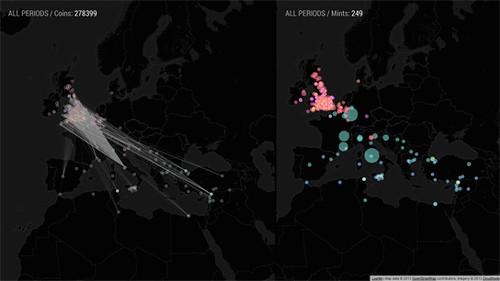
Today sees the launch of Lost Change, an innovative and experimental application that allows coins found within England and Wales and recorded through the British Museum’s Portable Antiquities Scheme (PAS), to be visualised on an interactive, dual-mapping interface. This tool enables people to interrogate a huge dataset (over 300,000 coin records can be manipulated) and discover links between coins’ place of origin (the issuing mint or a more vague attribution if this location is uncertain) and where they were discovered and then subsequently reported to the PAS Finds Liaison Officers.
While much of the the data is made available for re-use on the PAS website under a Creative Commons licence, some details are closely guarded to prevent illicit activity (for example night-hawking or detecting without landowner permission) and so this application has been developed with these restrictions in mind. An object’s coordinates are only mapped to an Ordnance Survey four-figure National Grid Reference (which equates to a point within a 1km square), and only if the landowner or finder has not requested these to be hidden from the public.
The tool is straightforward to use. The left hand pane holds details for the place of discovery; the right hand side holds details for the place of issue, the mint. These panes work in tandem, with data dynamically updating in each, depending on the user’s choice.
To read the complete article, see: Lost Change: mapping coins from the Portable Antiquities Scheme (blog.britishmuseum.org/2014/02/19/lost-change-mapping-coins-from-the-portable-antiquities-scheme/)
UNIQUE COIN FIND IN TURKEY 'DEMON TRAP'
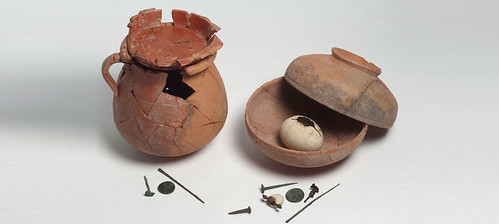
The ruins of Sardis, in what is now Turkey, have been a rich source of knowledge about classical antiquity from the 7th century BC, when the city was the capital of Lydia, through to the later Greek and Roman occupations.
However, Sardis has given up another treasure in the form of two enigmatic ritual deposits, which are proving more difficult to fathom than the coins for which the city was famous.
“The two deposits each consist of a small pot with a lid, a coin, a group of sharp metal implements and an egg, one of which is intact except for a hole carefully punched into it in antiquity,” explains Will Bruce, a classics graduate student a the University of Wisconsin-Madison who has been digging at Sardis for the past six years.
The dig at Sardis is overseen by Nicholas Cahill, a UW-Madison professor of art history. Cahill has directed field research at the site for decades. Both ritual deposits, says Cahill, date from the Roman era and based on the location of the find, date to between AD 70 or 80. The team were excavating below the floor of a first century room, which had been built over the ruins of an earlier building, probably destroyed in a massive earthquake in AD 17. Digging beneath the floor, Bruce and his colleagues first uncovered a thin-walled, near intact jug and close to this, an assemblage of mostly unbroken pottery.
“The meaning of these deposits is still quite open to interpretation,” notes Cahill, “but burying votive deposits below ground or in a wall was a fairly common practice,” perhaps as a ritual offering to protect the house against demons. Roman literary sources suggest eggs were used in particular rituals – in one case, the egg is used to entice demons inside where they are then magically trapped.
For the archaeologists, part of the intrigue is that similar groups of bowls, needles, coins and eggs were discovered at Sardis more than 100 years ago when the temple of Artemis was excavated by Princeton University archaeologists. “It is an exact parallel to what they found in the early 20th century,” according to Cahill.
Sardis is famous as the place where coinage was invented in the Western world, first using electrum, an alloy of silver and gold, and later of pure gold and silver. Nearby sources of gold made ancient Lydia, and King Croesus, fabulously wealthy. While these Lydian coins are very rare, coins and coin hoards from later Greek and Roman occupiers of Sardis are routinely found.

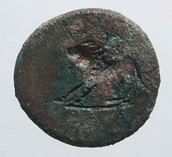
But the coin found with the egg, says Cahill, seems to be special. “The coin has a portrait of Nero on the front. The original reverse was hammered flat, and the image of a lion engraved in its place, which is very odd.” Expert numismatists have never seen anything like it. “The image of the lion is important because it is emblematic of the Lydian kings and of their native mother goddess Cybele,” Cahill says.
To read the complete article, see: SARDIS DIG REVEALS DEMON TRAP (www.pasthorizonspr.com/index.php/archives/03/2014/sardis-dig-reveals-demon-trap)
THE BOOK BAZARRE
ODYSSEY MARINE TO ATTEMPT SS CENTRAL AMERICA SALVAGE
 The long wait to bring up the remaining gold from the SS Central America shipwreck may soon be over.
The long wait to bring up the remaining gold from the SS Central America shipwreck may soon be over.
Odyssey Marine Exploration of Tampa will announce today that it has been chosen to retrieve what’s believed to be millions of dollars worth of gold coins, bars and ingots left behind 25 years ago by Columbus America Discovery Group, the Columbus-based shipwreck-salvaging company that found the wreck.
Ira O. Kane, the court-appointed receiver for Columbus America, has been working to set the recovery in motion.
“If all goes well, weather permitting, we’re prepared to begin,” he said. “We’re going to return to the Central America.”
Former Battelle scientist Tommy Thompson led a successful search in the late 1980s for the ship, a steamer that sank along the East Coast in 1857 with tons of gold in its hold. Thompson and his crew retrieved 3 tons of gold, silver and artifacts from the wreck, financed by $22 million from mostly central Ohio investors.
Odyssey’s hiring and its agreement with the receivership are subject to approval by Judge Pat Sheeran. Kane said he will file documents about Odyssey with the court on Wednesday. Odyssey could begin the recovery as early as April 1, Kane said.
He selected Odyssey after seeking recovery proposals from nine companies.
The company discovered the SS Republic, a Civil War-era shipwreck, in 2003 and the HMS Victory, which sank in 1744, in 2008.
Its salvage of the British cargo steamship SS Gairsoppa, a 1941 shipwreck nearly 3 miles deep, has resulted in the recovery of more than 110 tons of silver. The Central America shipwreck is 8,000 feet deep off the coast of South Carolina.
To read the complete article, see: Company selected to retrieve ship’s gold (www.dispatch.com/content/stories/business/2014/03/03/company-selected-to-retrieve-ships-gold.html)
'Remember, only 5 percent of this ship was excavated (in 1988),' Kane told The Associated Press on Thursday. "Obviously we hope that there is substantial value there and that we can return that value to our shareholders and to the creditors. If we can do that after 20-some odd years, I think it'd be a job well done."
The SS Central America was in operation for four years during the California gold rush before it sank after sailing directly into a hurricane in September 1857 in one of the worst maritime disasters in American history; 425 people were killed and thousands of pounds of gold sank with it to the bottom of the ocean.
To read the complete article, see: $100m treasure of legendary 'Ship of Gold' to be raised after 157 years: Salvage firm to raise sunken bounty from vessel that sank with 421 passengers (www.dailymail.co.uk/news/article-2575078/Florida-firm-pursue-disputed-sunken-gold.html)
Bob Evans writes:
I would like the readers of this forum to know that I am excited to be returning to the site of the S.S. Central America treasure in the near future. I am working again for the original business that discovered the legendary treasure, and I will now be able, on behalf of the Receiver, to resume the business of discovering, recovering, and studying this most amazing of American numismatic time capsules. I am eager to continue this work after a hiatus of over two decades. Many wonders remain to be found.
SOME NEW COIN DESIGNS: MARCH 9, 2014
New Zealand Duke and Duchess of Cambridge Visit
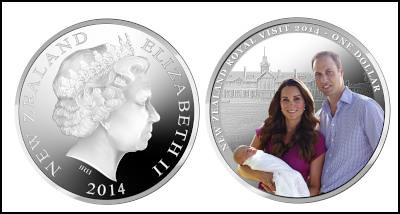
The photo quality of the image is amazing; what do these colored coins look like in person?
Latvia Ainazi Nautical School
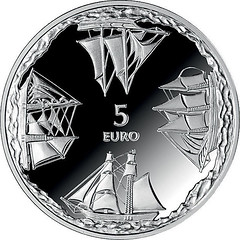
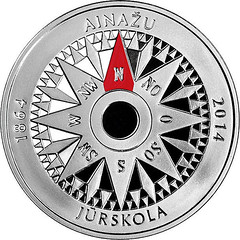
Four ships for our nautical topical collectors, and a little bit of color on the reverse. I like this one.
Romania Court of Accounts Anniversary
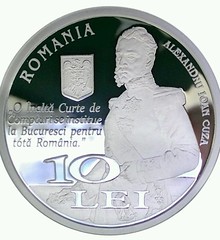
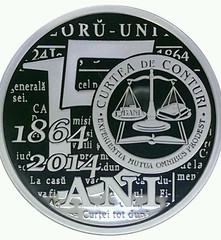
"Wordy" coin designs are generally to be avoided, but I kind of like the artistic arrangement on the reverse of this one.
QUERY: BALD PEOPLE ON COINS
Hubert Walker writes:
I'm sitting here, playing with the kids, and the weirdest question enters my head: how rare are bald people on coins? The U.S. features at least two, Ben Franklin and Dwight D. Eisenhower. If we're counting Franklin, then we should probably count the John Quincy Adams and Martin Van Buren presidential dollars. There are several balding presidents, but I'm talking about a full-on chrome dome. I don't know about world coins but I can't think of any off the top of my head. See what I did there? "Top of my head"?? I promise the puns will stop if your readers can tell me how rare a bald head is among the world's coinage.
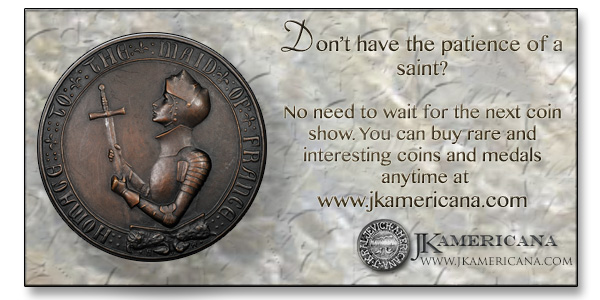
EDWARD VI SHILLING FOUND VICTORIA, BRITISH COLUMBIA
 An amateur treasure hunter with a hand-held metal detector has turned Canadian history on its head after finding a 16th century shilling buried in clay on the shores of Vancouver Island.
An amateur treasure hunter with a hand-held metal detector has turned Canadian history on its head after finding a 16th century shilling buried in clay on the shores of Vancouver Island.
The 435-year-old coin discovered in western-most Canada has rekindled a theory that a British explorer made a secret voyage here two centuries before it was discovered by Spanish sailors.
Official historical records show the Spanish were the first Europeans to set foot in what is now Canada's British Columbia province in 1774, followed four years later by British Royal Navy Captain James Cook.
Retired security systems installer Bruce Campbell found the coin in mid-December, along with a rare 1891 Canadian nickel, a 1960s dime and penny from 1900.
According to conspiracy theorists and some historians, the silver coin (produced between 1551 and 1553) is evidence that English explorer Sir Francis Drake traveled as far north as Canada's Pacific Coast during an expedition to California in 1579, in search of the famed Northwest Passage.
But he covered it up at the behest of Queen Elizabeth I, who supposedly wished to avoid confrontation over the new territory with Spain.
At the time, Spanish explorers had kept to more southern parts of the continent after disappointment (seeing few apparent resources and natural ports) in California.
Samuel Bawlf, a leading proponent of the so-called Drake theory and author of a 2003 book on the subject, says the coin is proof the English arrived here first.
He noted two other finds that support the theory: a 1571 sixpence dug up in 1930 in the backyard of a Victoria home and another Tudor-era coin unearthed on nearby Quadra Island.
Drake would have given the coins to aboriginals he met 'to show to later comers that England had already found (and staked a claim to) these lands,' Bawlf told AFP.
Royal British Columbia Museum curator Grant Keddie, tasked with examining the evidence, is skeptical.
He said his analysis typically looks at 'what was written at the time, and archeological artifacts'.
And there is currently not enough evidence to support this theory, he said, noting that Drake's logs were burned in a London fire a century later.
To read the complete article, see: Another victory for Drake: Amateur treasure hunter's coin find proves English hero discovered Canada before the Spanish (www.dailymail.co.uk/news/article-2573229/Amateur-treasure-hunter-turns-Canadian-history-head-finding-435-year-old-British-shilling-buried-clay.html)
History may turn on a shilling (triblive.com/usworld/world/5705258-74/british-coin-theory#axzz2vTcB5pAm)
COUNTERFEITERS HIT GIRL SCOUT TROOPS
At least two local crooks managed to swipe cookies and cash from a Girl Scout troop in Rancho Cucamonga using counterfeit money.
The Girl Scouts had just begun their annual cookie drive. Not only did the thieves buy several boxes of cookies with counterfeit money, but they also asked for change to be made.
"The girls are heartbroken," said troop leader Cheryl Williams. "Because they do trust, this is a life lesson for them."
The incident happened last Saturday after troops set up a table outside a local grocery store. A man and woman passed off the $50 counterfeit bills within minutes of each other.
Williams says the transaction seemed innocent enough.
"(The girls) used the counterfeit pen on the money, and it worked," Williams said.
They had been on the lookout for this type of crime after another troop was hit.
The troop believes they are out a little more than $200 from the incident, and Williams said the girls are liable for that money.
To read the complete article, see: Girl Scouts troop in California duped by counterfeit money (abclocal.go.com/ktrk/story?section=news/national_world&id=9453406)
BANK OF INDIA GOOFS GOVERNOR'S SIGNATURE
In an embarrassing goof-up, the Reserve Bank of India (RBI) has issued currency notes in 2014 carrying the signature of its former governor D Subbarao, who retired last year.
HT could not ascertain the exact denomination and total value of these flawed currency notes but sources said they are high denomination notes.
“These notes are not legal tender as they carry the signature of a retired RBI governor. To be valid, they ought to have carried current RBI chief Raghuram Rajan’s signature. However, they can be exchanged at any commercial bank,” said a senior bank official.
To read the complete article, see: Take note: RBI goofs up, invalid notes in circulation (www.hindustantimes.com/business-news/rbi-goofs-up-invalid-notes-in-circulation/article1-1190639.aspx)
FEATURED WEB PAGE: SS CENTRAL AMERICA ROBOT ARMS
This week's Featured Web Page has a neat video showing how robotic arms were used to recover gold bars, gold coins and other artifacts from the wreck of the SS Central America.The largest treasure cache in American history was found 200 miles off the South Carolina coast, in 8,000 feet of seawater. In 1857, while underway from Panama to New York with a cargo of gold from the California gold fields, the "SS Central America" with 578 souls on board, went down in a hurricane. Referred to as "The Ship of Gold", the SS Central America carried an estimated 3 tons of gold, much of which was in the form of gold bars (ingots) and thousands of rare coins, with some of the gold coins having estimated collector value of over $30,000 per coin.
Using an underwater robot equipped with a Kraft Grips force feedback manipulator arm, the Central America's cargo of gold bars, coins, and nuggets was carefully recovered from the sea floor, while respecting the archeological value of the wreck. The performance characteristics of the Kraft force feedback manipulator arm played an important role in the salvage operation, particularly with regard to preserving the pristine condition and collector value of the gold coins.
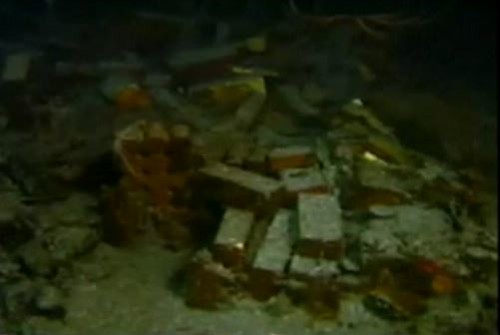
www.krafttelerobotics.com/industries/
undersea/treasure/index.html
